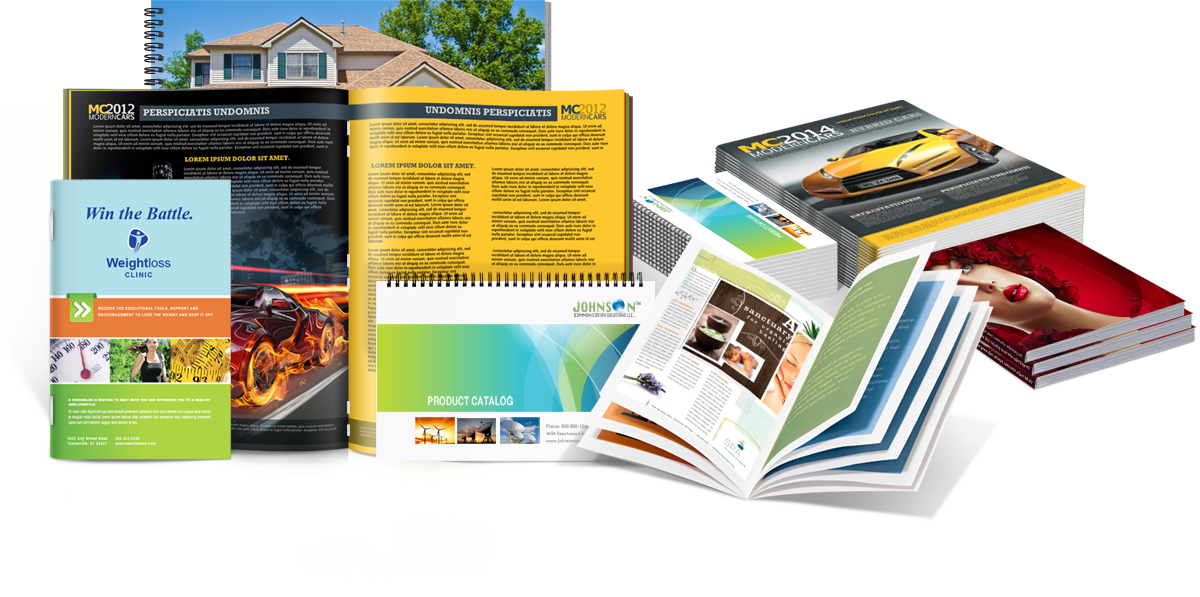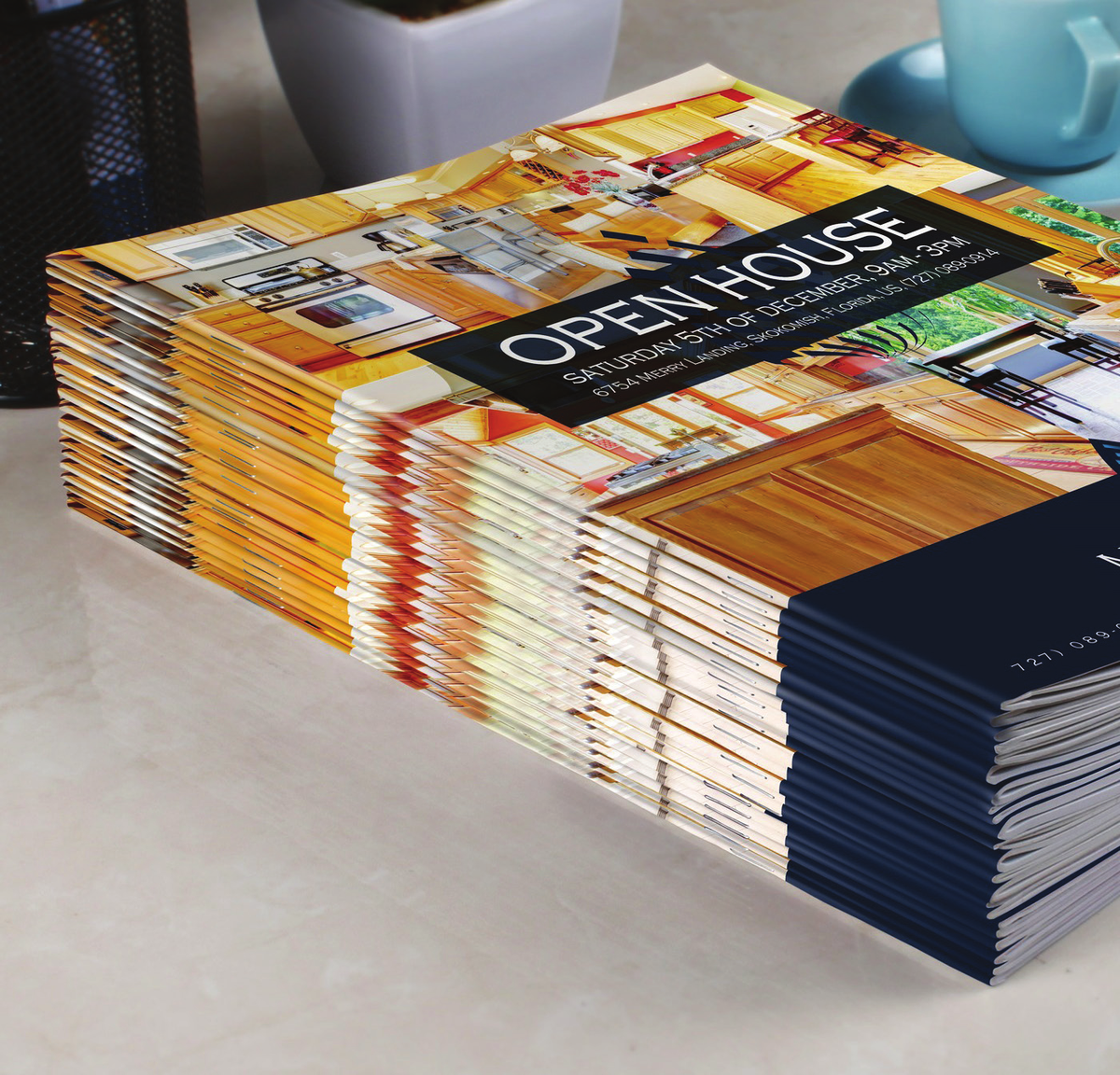The Crucial Overview to Comprehending Brochure Printing Options and Techniques
The process of booklet printing involves numerous factors to consider that can considerably affect the end product. From picking the proper style and size to understanding the subtleties of binding approaches, each option plays a vital role. In addition, variables such as paper stock and printing techniques more affect the effectiveness of the pamphlet. As one navigates these options, it comes to be critical to comprehend how they adjoin and what that indicates for the overall end result.
Comprehending Pamphlet Dimensions and formats
When taking into consideration pamphlet printing, understanding the different styles and dimensions available is important for accomplishing the wanted discussion. Pamphlets can be generated in many layouts, including saddle-stitched, spiral-bound, and perfect-bound, each offering distinctive benefits. Common dimensions range from typical letter (8.5 x 11 inches) to smaller alternatives like A5 (5.8 x 8.3 inches), permitting adaptability based on material and target audience.Selecting the ideal size can affect both the format and reader involvement. Bigger sizes may match visually driven material, while smaller sized formats may be a lot more easy to use and mobile. Additionally, the number of web pages influences the choice of binding technique, as thicker brochures might require sturdier bindings. Eventually, recognizing these facets permits a much more tailored technique, ensuring that the end product lines up with the designated message and visual, boosting the total effectiveness of the communication.
Choosing the Right Paper Stock

Binding Methods: Alternatives and Factors To Consider
When it involves binding methods for booklets, a number of alternatives are available, each with distinct advantages. Saddle stitch binding uses a cost-effective service for thinner brochures, while excellent binding strategies provide a more refined appearance for thicker magazines. Wire-O binding attracts attention for its resilience and ease of usage, making it suitable for papers that require adaptability.
Saddle Stitch Binding
Saddle stitch binding uses a affordable and functional option for constructing pamphlets, making it a preferred selection amongst organizations and authors. This binding approach entails folding sheets of paper in fifty percent and stapling them along the fold line, producing a orderly and neat appearance. Typically suitable for pamphlets with a reduced web page count, saddle stitching is perfect for magazines, sales brochures, and educational products. The simplicity of this technique enables fast manufacturing and is typically favored for short runs or advertising things. Nonetheless, it is necessary to note that saddle stitch binding may not appropriate for thicker brochures, as the spine might not stand up under enhanced weight. In general, it remains a reliable choice for numerous printing tasks.
Perfect Binding Methods
Perfect binding is a widely made use of technique that gives a expert and polished surface to booklets and magazines. This method entails gluing the pages with each other at the spine using a strong adhesive, allowing for a clean side and the ability to hold a larger variety of web pages contrasted to saddle sewing. Perfect binding is particularly ideal for thicker booklets, such as catalogs and yearly records, where a durable, level spine is preferred. In addition, it provides the alternative for a published cover that can be developed to boost visual charm. Nonetheless, considerations such as page matter, paper weight, and the planned use of the brochure must be taken into account, as they can impact durability and general high quality.
Wire-O Binding Choices
Wire-O binding, understood for its toughness and adaptability, offers an outstanding choice for brochures that need very easy web page transforming and a specialist look. This binding approach uses a collection of steel loopholes that hold web pages firmly, permitting them to exist level when open. It is specifically ideal for handbooks, brochures, and presentations because of its robust nature. Wire-O binding is available in numerous shades and sizes, accommodating different web page matters and thicknesses. Furthermore, it allows the inclusion of covers and tabs, boosting the booklet's general aesthetic. Considerations for Wire-O binding consist of the selection of cord shade, the size of the loopholes, and the level of personalization preferred, all of which can greatly affect the final item's look and performance.
Digital vs. Offset Printing: Which Is Best for You?
When selecting a printing approach for brochures, comprehending the distinctions in between digital and counter printing is necessary. Digital printing uses modern innovation to produce high-quality prints promptly and economically, making it ideal for brief runs or projects calling for quick turn-around times. It permits modification, supplying the ability you can try this out to publish on-demand with minimal waste.In contrast, counter printing is a standard method that stands out in producing big amounts with constant top quality. It includes moving ink from a plate to a rubber blanket, after that to the paper, which results in precise information and vivid colors. Balance out printing commonly calls for longer arrangement times and is a lot more affordable for bigger volumes.Ultimately, the choice between digital and offset printing depends on project demands, budget plan, and preferred quantity. For little, time-sensitive tasks, electronic could be the very best option, while balanced out might be more effective for larger, top notch productions.

Designing Your Pamphlet: Tips and Finest Practices
When developing a brochure, careful focus to format, font style option, and color usage can greatly boost its effectiveness. A well-structured design overviews the visitor's eye, while appropriate fonts ensure readability and convey the preferred tone. Furthermore, effective usage of shade can evoke emotions and highlight key details, making the overall style extra impactful.
Choosing the Right Layout
How can one properly select the appropriate layout for a booklet? It is vital to examine the booklet's purpose and target audience. A tidy, organized design boosts readability and engagement. Using a grid system can assist in aligning aspects regularly, producing a professional appearance. Additionally, integrating visual power structure with varying sizes and positionings of pictures and message can direct the reader's eye and emphasize crucial info. It is likewise vital to leave sufficient white space, which protects against overcrowding and permits better focus. Evaluating different layouts through mock-ups can give understanding right into just how the design does in real-world situations, making certain that the final product fulfills both aesthetic and useful needs. Practical Selecting Suitable Font Styles
An appropriate typeface can substantially enhance the total design of a brochure, enhancing the format and reinforcing the content's message. The choice of typefaces must consider readability, specifically for body text, as it assures the info comes to all readers. Sans-serif font styles are commonly liked for digital styles, while serif font styles can lend a conventional feeling in printed products. It's recommended to limit font options to 2 or 3 to maintain visual comprehensibility. Additionally, typeface dimension plays an essential role; headings need to be not frustrating however unique, while body text should fit for analysis. When choosing fonts, alignment with the pamphlet's style and target audience is important for effective interaction and aesthetic appeal.
Reliable Use Color
Color offers as a powerful device in brochure layout, shaping perceptions and assisting visitor feelings. It can evoke sensations of calmness, enjoyment, or trust, depending upon the tones selected. Designers must consider shade theory concepts, making sure that the chosen scheme lines up with the booklet's message and target market. Using warm colors like red and orange can produce seriousness, while cooler tones like blue and environment-friendly foster tranquility.Additionally, contrast plays an important function; complementary colors can improve readability and aesthetic charm. Uniformity in shade use throughout web pages additionally reinforces brand name identification and communication. Inevitably, reliable shade execution not just catches interest yet additionally strengthens the brochure's purpose, making it a crucial element of successful design.
Ending Up Touches: Coatings and Unique Effects
While numerous consider the web content and layout of a pamphlet one of the most vital aspects, the explanation finishing touches, such as finishings and special results, play a vital duty in improving its total allure. Coatings can give protection and sturdiness, making certain that the booklet withstands wear and tear. Matte surfaces offer a sophisticated, non-reflective surface, while glossy coverings can make shades show up even more vivid and attractive. Unique results, like embossing or aluminum foil marking, add a tactile dimension that can develop an unforgettable impact. These methods can highlight specific areas, attracting focus to essential information or creating aesthetic interest. In addition, UV finishing can provide a high-shine coating that raises the general look.Together, these completing touches not just improve the pamphlet's aesthetic however additionally connect professionalism and focus to information, inevitably leaving an enduring effect on the visitor.
Cost Considerations for Brochure Printing
Recognizing the numerous price factors to consider for booklet printing is essential for businesses and organizations aiming to optimize their spending plans. Trick factors affecting costs include the option of binding, ink, and paper techniques. Higher top quality materials, such as exceptional paper or specialized inks, commonly increase the overall expense. Additionally, the dimension and web page matter of the booklet play a substantial function; bigger brochures require more sources and time to produce.Another important consideration is the printing technique, whether electronic or offset, as each has its very own rates framework and viability for different amounts. Companies should additionally factor in layout expenses, which can differ based on complexity and the use of expert solutions. Eventually, delivery and handling charges can include in the other total amount, especially for large orders. By assessing these aspects, organizations can make informed decisions that align with their monetary abilities while achieving the desired quality in their published products.
Regularly Asked Inquiries
What Are the Environmental Impacts of Brochure Printing?
The ecological influences of booklet printing consist of logging from paper production, carbon emissions from transportation, and waste generation from disposed of products - Booklet Printing. Lasting methods, such as making use of recycled paper and environmentally friendly inks, can reduce these effects
Just How Can I Ensure Color Precision in My Pamphlet?
To ensure color precision in a brochure, one ought to make use of calibrated displays, use expert color accounts, carry out examination prints, and choose high-quality printing solutions that use color matching and proofing alternatives for finest outcomes.
What Is the Normal Turnaround Time for Booklet Printing?
The normal turnaround time for pamphlet printing varies relying on the intricacy and amount - Booklet Printing. Generally, it varies from a few days to 2 weeks, influenced by elements such as printing approaches and completing requirements
Are There Minimum Order Quantities for Pamphlet Printing?

Can I Publish Brochures in Multiple Languages?
Printing brochures in several languages is feasible. Several printing solutions offer choices for multilingual or multilingual formats, permitting efficient communication. Cautious planning assurances that make components suit various languages without compromising readability or aesthetic appeals. Additionally, variables such as paper stock and printing methods more influence the efficiency of the pamphlet. When considering booklet printing, recognizing the various formats and sizes readily available is important for accomplishing the wanted discussion. When picking a printing technique for pamphlets, recognizing the distinctions in between digital and offset printing is essential. Additionally, the dimension and web page count of the booklet play a significant role; larger pamphlets call for even more resources and time to produce.Another important factor to consider is the printing strategy, whether digital or balanced out, as each has its own rates framework and suitability for different amounts. The environmental influences of brochure printing include logging from paper manufacturing, carbon emissions from transport, and waste generation from thrown out materials.